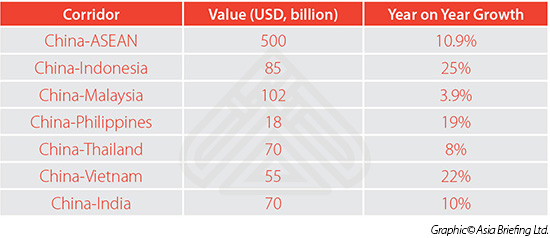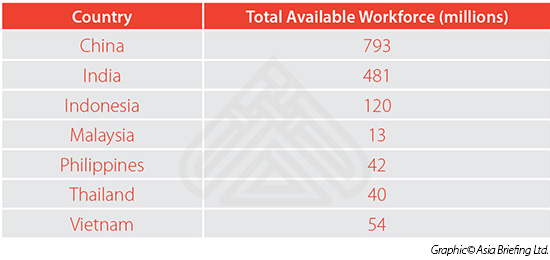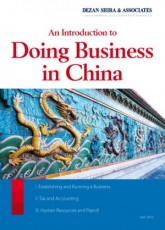China and Asia’s Free Trade Corridors and Beneficial Tax Agreements
Both China and most other Asian nations have been highly assertive in their use of Double Tax and Free Trade agreements over the past five years, as the reality of rising prices in China coupled with an emerging consumer class dictate that intra-Asian trade flows are growing as an astounding rate. While China’s President Xi Jinping indicates that China’s GDP this year may drop to 7 percent, the alternative story is the growth in China’s trade corridors. In this snapshot below we can see the growth trajectory between China trade and ASEAN as a whole, break that down into the ASEAN five main manufacturing nations, and with India. All figures are 2014 estimates.

Of these, the three to watch are ASEAN overall, where bilateral trade is expected to reach US$1 trillion by 2020, India, where bilateral trade is expected to rocket to US$ 250 billion in the same period, and Vietnam, whose AEC compliance at the end of this year can be expected to see trade rise to some US$ 150 billion during this time frame. In fact, all the ASEAN economies, and those beyond, are expected to see bilateral trade increase by amounts faster than China’s own domestic GDP during the next five years.
The main part of this existing phenomenon is the driver that China itself has become. It is a huge economy, with huge potential for reaching out to its middle class consumer base, itself scheduled to reach 600 million people by 2020. Media headlines that China is ‘slowing’ are partially misleading, it is impossible to maintain double digit growth rates ad infinitum. China-ASEAN trade now runs both ways. Where China was once solely an export competitor, it is now fast turning into one of ASEAN’s most important consumer markets. ASEAN states themselves are playing an increasingly larger role as export destinations for China as well. In addition, countries like Indonesia, the Philippines, Malaysia, Thailand and Vietnam, with their large labor pools are attractive production locations for Chinese companies.
The same is also true of India, which is going through its own demographic changes. It is worth remembering that of all the Asian nations, only India has the workforce size to be able to get anywhere near matching Chinese levels.
While Vietnam is right on China’s doorstep and offers relatively easy access to mainland China, it remains only part of the solution of meeting China’s consumer demands. With a country the size of China clamoring for a sustainable supply of cheap manufactured goods – and food – it is of interest to note which of these countries possess the largest amount of available workers:

Clearly, Vietnam is not going to be “the new China” as many suggest. Its available workforce is less than 8 percent of China’s. But India certainly has that potential – and its worker demographic is expected to keep growing, just as China’s reduces. It will be firstly the Vietnamese and other ASEAN labor forces that come into play when looking to service China as a consumer hub, followed by India, as soon as its new Government have their reforms properly in place and better infrastructure is operational. These steps are being taken now. The “new China” will ultimately be India, from about 2020 onwards.
In the meantime, these China trade corridors can be expected to continue to grow. An important part of this when dealing with international trade is to understand the various free trade and double tax treaty benefits that China has signed off with these nations. Foreign investors based in any of these countries can access these agreements, which can not just reduce import-export tariffs, but also offer tax reduction mechanisms to international businesses by outlining areas in which employees sent to work for a period in these nations are not taxed, as well as provide mechanisms for reducing income tax liabilities.
Dezan Shira & Associates has been busy the past few months researching and analyzing the various treaties that exist, and highlighting how these can be of benefit to foreign companies wanting to trade not just with China, but with other countries in Asia as well. These are available in our various magazines, as follows:
 An Introduction to Tax Treaties Throughout Asia
An Introduction to Tax Treaties Throughout Asia
Includes a guide to tax treaties entered into across Asia, including DTA as well as Bilateral Investment Treaties and how these can be of benefit to international traders.
Using China’s Free Trade & Double Tax Agreements
Includes all of China’s double tax treaties and the countries these have been signed with, how they work and how to use them to your financial advantage when operating in or with China.
 Using India’s Free Trade & Double Tax Agreements
Using India’s Free Trade & Double Tax Agreements
India, like China, also has a Free Trade Agreement with ASEAN, and multiple double tax agreements. We explain how these can be leveraged for ASEAN trade as well as internationally.
 Using Vietnam’s Free Trade and Double Tax Agreements
Using Vietnam’s Free Trade and Double Tax Agreements
Details all of Vietnam’s Free Trade and DTA, the countries that have signed off on these, together with rules of origin issues and the cross border tax minimization advantages they offer.
As the developing China trade corridors indicate, getting your business into these spaces is going to be the new development trend. Maximising the lower operational costs now available elsewhere in Asia, and marrying that to the developing middle class consumer market arising not just in China, but within ASEAN itself as well as India, is the way ahead for the next two decades. Understanding Asia, as well as China, is key to this, as is a knowledge of the various Free Trade and Double Tax Agreements that go with this territory.
|
Chris can be followed on Twitter at @CDE_Asia. Stay up to date with the latest business and investment trends in Asia by subscribing to our complimentary update service featuring news, commentary and regulatory insight.
|
![]()
 An Introduction to Doing Business in China
An Introduction to Doing Business in China
The China Briefing Business Guide to Doing Business in China is the definitive guide to one of the fastest growing economies in the world, providing a thorough and in-depth analysis of China, its history, key demographics and overviews of the major cities, provinces and autonomous regions highlighting business opportunities and infrastructure in place in each region.
 An Introduction to Doing Business in Vietnam 2014 (Second Edition)
An Introduction to Doing Business in Vietnam 2014 (Second Edition)
An Introduction to Doing Business in Vietnam 2014 (Second Edition) provides readers with an overview of the fundamentals of investing and conducting business in Vietnam. Compiled by Dezan Shira & Associates, a specialist foreign direct investment practice, this guide explains the basics of company establishment, annual compliance, taxation, human resources, payroll, and social insurance in the country.
 An Introduction to Doing Business in India 2015 (Second Edition)
An Introduction to Doing Business in India 2015 (Second Edition)
Doing Business in India 2015 is designed to introduce the fundamentals of investing in India. As such, this comprehensive guide is ideal not only for businesses looking to enter the Indian market, but also for companies who already have a presence here and want to keep up-to-date with the most recent and relevant policy changes. We discuss a range of pertinent issues for foreign businesses, FDI caps and restrictions, the key taxes, how to conduct a successful audit, and the procedures for obtaining an employment visa.
- Previous Article Outlook on Light Manufacturing in China: March 2015
- Next Article Manufacturing in Asia to Sell to China’s New Growth: Legal Structures











